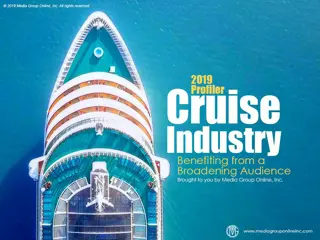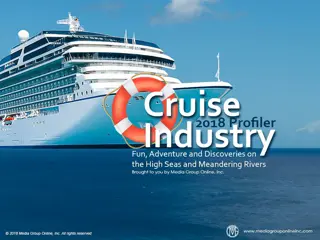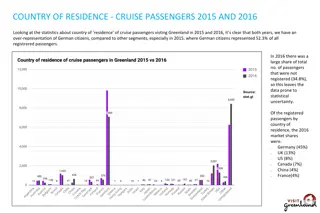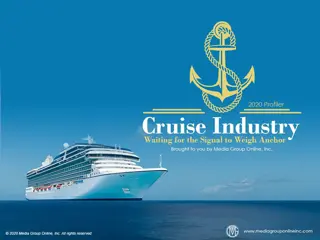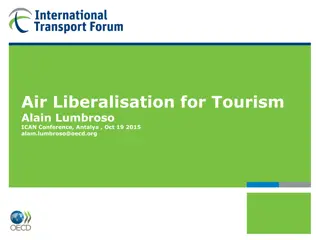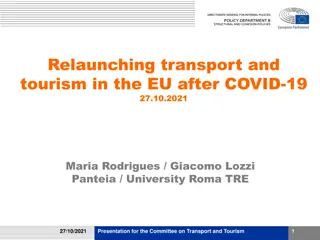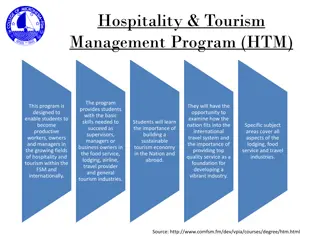Introduction to Cruise Ships in the Tourism Transport Industry
Cruise ships are passenger vessels designed to offer a complete tourist experience with cabins and entertainment facilities. This chapter explores the significance of cruise products in providing transportation, accommodation, and leisure services aboard, emphasizing the experiential aspect over the actual transportation function. The institutional framework in maritime affairs, including the International Maritime Organization (IMO) and UNCLOS, is discussed. The demand for cruise travel has been rapidly growing, particularly internationally, and vessel ownership and market shares of major cruise companies are outlined.
Download Presentation

Please find below an Image/Link to download the presentation.
The content on the website is provided AS IS for your information and personal use only. It may not be sold, licensed, or shared on other websites without obtaining consent from the author. Download presentation by click this link. If you encounter any issues during the download, it is possible that the publisher has removed the file from their server.
E N D
Presentation Transcript
Introduction to Tourism Transport Tourism Transport Introduction to SVEN GROSS LOUISA KLEMMER
Chapter 8 Cruise Ships
Cruise Ships cruise ship: a passenger ship intended to provide passengers with a full tourist experience. All passengers have cabins. Facilities for entertainment aboard are included (Glossary of Transport Statistics, 2009) cruise product complex package of transportation, accommodation and leisure facilities on board itinerary of several destinations to be visited overall experience is of primary importance transportation itself plays only a secondary role
Institutional Framework IMO = International body responsible for maritime affairs Treaty - UNCLOS maritime zones Source : Adapted from The United Nations Convention on the Law of the Sea, 1998
Demand fastest growing segment within the leisure travel market average annual passenger growth rate: approx. 7.5% between 1980 and 2012: 225 million passengers International demand (numbers of passengers in millions) 25 20 2.91 2.25 2.18 1.45 1.37 15 6.18 1.29 5.54 5 4.46 4.05 3.44 10 0.87 2.14 11.5 11.11 10.45 10.4 10.38 5 10.29 6.91 0 2001 2006 2007 2008 2009 2010 2011 North America Europe Rest of the world Source: Adapted from G.P. Wild, 2012
Supply Vessel ownership Independent shipping company Ship owner Financing company Leasin g Management Charte r Power of disposition Shipping company Charter, Cruise sales Charter, General sales agent, Commissio n sales agreement s Charter General sales agent, Commission sales agreements Tour operator Broker of the ships Cruise sales Cruise sales Cruise sales Cruise customer Uncommon operating model Common operating model Source: Adapted from Gross, 2011
Supply Market shares of the major cruise shipping companies in 2010 (percentage share of berths) Others 18% Mediterranean Shipping Cruises 6% Carnival 46% Star Cruises 8% Royal Caribbean Cruises 22% Source: ISL, 2012; ships of 1000 gt and over
Supply Passenger capacity of world active cruise fleet 1990 2012 500 450 400 350 300 1000 berths 250 200 150 100 50 0 1990 1992 1994 1996 1998 2000 2002 2004 2006 2008 2010 2012 Source: ISL, 2012; ships of 1000 gt and over
Supply World passenger and cargo passenger fleet: average size development 1991-2012 12000 10500 9000 7500 gt 6000 4500 3000 1991 1993 1995 1997 1999 2001 2003 2005 2007 2009 2011 Passenger ships Passenger/rorro cargo ships Source: ISL, 2012


